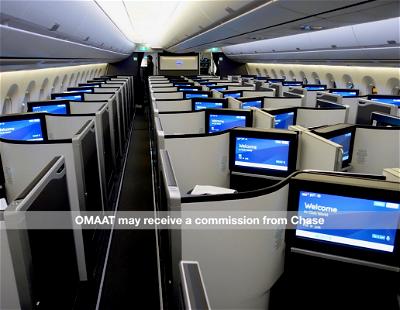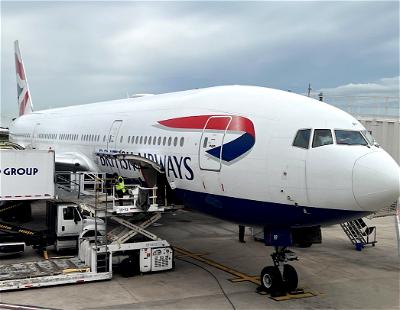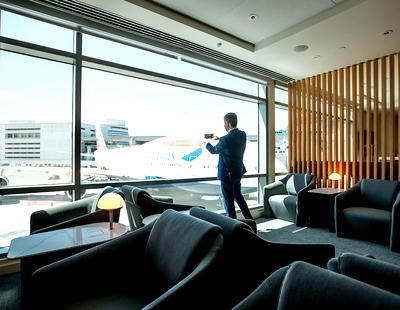We’ve seen an increase in fume related incidents on commercial flights. In some cases this impacts the crew, in other cases it impacts passengers, and in some cases it impacts everyone. This has led to all kinds of diversions.
Well, AvHerald has the rundown of what’s possibly the most terrifying fume related incident we’ve seen in quite a while.
This incident involves BA2676 on October 19, 2019. This was a British Airways A320 operating a flight from London Gatwick to Paphos in Cyprus.
The plane was descending through 8,000 feet to 6,000 feet when the first officer noticed an unusual odor in the cockpit (which he described as smelling like onion bajhis… yum!), and even asked the captain if he smelled it. The captain said he didn’t smell it.
Just 30 seconds later the first officer felt his arms and legs tingling and had the impression he was about to faint, so he put on his oxygen mask and set the oxygen level to 100%.
He then turned to the captain to tell him he wasn’t feeling well, but when he did, there was no response, as the captain was incapacitated. After a couple of seconds the captain reacted slowly, saying he didn’t feel well either, and he also put on his oxygen mask and turned the oxygen level to 100%.
During this period the pilots missed several calls from ATC to descend to 4,000 feet, since obviously their primary focus was making sure they could safely operate the plane.
Since both pilots had oxygen masks on they couldn’t talk to one another, so they communicated with hand signals, as the captain flew the plane while the first officer went through the checklist, operated the levers, etc.
The plane landed safely 13 minutes after the trouble started, and the crew opened the cockpit windows as soon as they landed.
The captain went to the lavatory after landing, and the first officer went into the cabin to make sure everything was okay. While everything in the cabin was alright, the flight attendant noticed how pale the first officer was, and noted that there was a strong smell of fuel when the cockpit door opened.
The pilots were hospitalized and were diagnosed with low blood oxygen saturation and fever. The pilots ended up flying back to London the next day as passengers. The plane returned to London Gatwick the next day, about 27 hours after it landed in Paphos.
The plane in question has the tail number G-GATL, and it’s 17 years old, and it first flew for ACES Colombia, then Wizz Air, and then British Airways as of 2015.
It’s also interesting to note that on October 2 the plane diverted to Athens due to smoke in the cabin, and on October 17 the plane diverted to Porto while enroute to Marrakech. The fourth flight after that was the flight that ended up having this issue.
With these kinds of incidents becoming more common, you sure have to wonder what exactly is going on. Hopefully the severity of this situation leads to a more thorough investigation.
Kudos to the pilots for being so observant and aware, or else this could have ended very differently…





I have been a FA at a major US airline for 30 years and have never heard of a fume event until the last couple of years. And now I hear about them often. Do they occur mostly on the Airbus? The Airbus is relatively new to my employer and is becoming a prominent aircraft in our fleet. I’m wondering if the insurgence of the Airbus and the increased attention to fume events are not a coincidence.
Mel R, that's true, however the crew (while in a state of reduced mental capacity) would need to select their hot-mic interphone to "on" and also needs to have their headset or speaker on.
They may have had their interphone off.
It’s incorrect that crew communication is not available while donning oxygen masks. There is an intercom and ATC radio com built in.
Also, I forgot to mention, on the A320 the left engine (number 1) feeds the cockpit with pressurized and conditioned air.
The right engine (number 2) feeds the main cabin with pressurized and conditioned air.
If the source of contamination is the left engine, it is 100% expected that the cockpit would be primarily and disproportionately affected, and not the main cabin.
I am an A320 pilot, have been for several years now for a major airline.
These events are absolutely 100% real. I have experienced them first hand, as well as the associated negative health impacts.
Some pilots have had career-ending fume events.
The primary contaminant is engine/APU oil the leaks past worn or failed turbine seals and enters the cockpit/cabin because the aircraft is pressurized from air that is pulled from the engine/APU compressor section.
...I am an A320 pilot, have been for several years now for a major airline.
These events are absolutely 100% real. I have experienced them first hand, as well as the associated negative health impacts.
Some pilots have had career-ending fume events.
The primary contaminant is engine/APU oil the leaks past worn or failed turbine seals and enters the cockpit/cabin because the aircraft is pressurized from air that is pulled from the engine/APU compressor section.
Please Google "aerotoxic syndrome". There is an association, and considerable print and video content.
The aircraft/engine/APU manufacturers, the airlines, the FAA and other world regulators are, at worst, engaging in a complete cover up. At best, they are pretending it's not happening publicly.
I've spoken directly with airline employees disciplined for attempting to write these aircraft up after events.
This is a problem that will require the media, the public and Congress to address.
As for the pilots not being able to communicate with the oxygen mask on, they were in a state of reduced mental ability, and probably forgot to select their hot-microphone to on or didn't put their headsets on.
As for the person who said these are left in the "100%" setting during preflight, I have personally found them left in the "N" setting even though that is not where they are supposed to be left.
The maintenance person above may be able to say. I am now t familiar with the bleed system on the 320 but perhaps in normal ops, the bleed air to the flight deck comes from one engine and the other supplies the cabin etc. Possible bleed air leak into their vent system.
@Psychopompos
A dumbed down report of this incident appeared in the Cyprus media on 20 Oct. It is fully corroborated.
What's so disturbing is the way BA kept it quiet for over a month. Probably the fact that the fumes were confined to the cockpit meant that none of the passengers were aware of it.
So I take it this plane is owned by a lease company, who leased it to the Colombian airline, then Wizz, then BA?
Wonder why Wizz no longer wanted it but BA did. Do Wizz tend to keep a fairly modern fleet? I guess BA are known to be happy with old birds
This is clearly completely made up. Why are you copy-pasting something with zero corroboration from an authoritative source?
They should have opened the cockpit door to mix the cockpit air with the main cabin air at least. Then maybe put full flaps on to decrease speed asap and since they were only at 6,000 ft, then crack the windows after getting down to less than 300 mph.
Having been in a Level D A320 simulator practicing a very similar scenario a few hours ago, I can say there are a few things a bit off with this story.
The pilots should have been fully capable of communication as the microphone in the oxygen mask operates automatically through the intercom system; unless they forgot to put their headsets back on after they fitted their masks, then they wouldn't be able to hear...
Having been in a Level D A320 simulator practicing a very similar scenario a few hours ago, I can say there are a few things a bit off with this story.
The pilots should have been fully capable of communication as the microphone in the oxygen mask operates automatically through the intercom system; unless they forgot to put their headsets back on after they fitted their masks, then they wouldn't be able to hear anything of course.
The O2 masks should always be set to deliver 100% before every flight and this is part of the pre-flight oxygen system test.
With that in mind, as has been pointed out, the use of the oxygen masks is very rarely practiced so its not hard to see how mistakes are made easily.
They need a little sim refresher on how to properly use the O2 mask and communicate. That's a weak point on many airline training courses.
How is it possible that fuel vapor was present in the cockpit to such a high concentration that the pilots were being oxygen deprived. That would take a huge concentration of fuel vapor, something noticeable LING before you black out.
Just go on youtube and type in "Australian 60 minutes asbestos airline" and you will find out why these pilots occasionally are breathing toxic air. Having flied a lot in the past few years, I came across such a thing recently. Luckily it was a short flight and I was glad to get out of that plane. When asked flight attendants about it when I first smelled it, they claimed someone was eating curry they...
Just go on youtube and type in "Australian 60 minutes asbestos airline" and you will find out why these pilots occasionally are breathing toxic air. Having flied a lot in the past few years, I came across such a thing recently. Luckily it was a short flight and I was glad to get out of that plane. When asked flight attendants about it when I first smelled it, they claimed someone was eating curry they brought from home thus causing the smell. However, I've eaten a lot of curries in my lifetime and that definitely was not a curry smell...
Nice job literally plagiarising word for word from Avherald/Flyertalk without a quotation block. You didn't write those words. It's theft.
Also, BA is a trash airline
There re microphones in the oxygen masks on the A320 (I'm an engineer on them) so that is wrong. If they could use hand signals then they could also speak to each other no doubt. Still a major incident either way.
Interesting. I was a pax on this very airframe a few weeks ago shortly after it returned to service following this incident, but was unaware of the history.
They can communicate when on Oxygen. It requires an extra step, which they apparently weren't coherent enough to do. That's how bad it was and how close they were to a much worse situation.
@Jay
I understand you inflate the autopilot...
Just curious. What exactly can anyone do if both pilots end up incapacitated? Are there even protocols for this scenario?
Since when can't pilots talk when they have their oxygen masks on? Or is that just on the newer models?
Bah. Hope this is specific to that aircraft only and not an A320 problem. I have an easyJet flight coming up soon